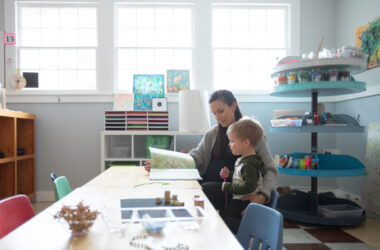
Scott Miller, the Domestic Abuse Intervention Programs executive director at the Duluth Project in Minnesota says one key to solving domestic violence is changing the climate of tolerance for the crime. (Submitted photo).
[ EDITOR’S NOTE: This project was produced in partnership with the Solutions Journalism Network as part of the Enterprise’s effort to take a fresh approach to reporting community issues. ]
A Malheur County man holds a screwdriver to his partner’s throat after sneaking up on her as she opens her car door.
Another man slaps his pregnant wife and then punches her, leaving her with a black eye.
A Nyssa man holds his former girlfriend hostage, eventually kills her and sparks an hours-long police standoff. The standoff ends when the man is later shot by police as he runs toward them with knife.
Domestic violence in Malheur County is chronic, as much a part of the local landscape as poverty and onion fields.
The issue came into high profile recently when a restraining order was issued against an Ontario city councilor over allegations of violence. The order was second in a year imposed on Freddy Rodriguez, who has denied any abuse.
An examination by the Malheur Enterprise found programs in other communities that hold possible solutions for the local community. Domestic abuse can be reduced. But the work isn’t easy or cheap.
Domestic violence remains a threat to community security in Malheur County and across the U.S.
A U.S. Centers for Disease Control and Prevention assessment found that approximately one out of every three women is a victim of rape, assaults or stalking by an intimate partner. Intimate partners accounted for half the murders of women.
Often relegated to the shadows and behind closed doors, domestic violence is also a major drain on taxpayers. The CDC estimates domestic violence costs nearly $6 billion a year in lost earnings and heath care expenses.
Statistics often tell only part of the story, but based on information from the Ontario Police Department and the Malheur County Sheriff’s Office, domestic violence is a woefully familiar local tale affecting hundreds of victims.
In 2018 the sheriff’s office responded to 242 domestic violence calls, leading to 13 arrests. In 2019 deputies responded to 260 domestic violence calls. For 2020 through September, the office logged 281 domestic violence cases.
In 2019, the Ontario Police Department handled 243 calls regarding some type of domestic violence. Up to October, 2020, the OPD responded to 185 domestic violence calls.
Locally, victims and batterers have access to help but it’s a patchwork of government and nonprofit services.
Administrators of programs elsewhere in the country told the Enterprise that a unified community approach provides the best chance of cutting down on violence.
Midwest effort
For more than 40 years, the lakefront city of Duluth Minnesota, has been home to one of the most respected domestic abuse programs in the country.
The Duluth Model has been replicated in one community after another, focusing on taking the blame off the victim while paying close attention to their experiences.
Scott Miller, the Domestic Abuse Intervention Programs Executive Director, said one key is to “change the climate of tolerance for domestic violence in the community.”
“We’ve moved beyond this notion that we develop a service and wait for it to happen and, once it happens, do something about it,” said Miller.
That united effort is embodied in the Domestic Violence Response Team – a collaboration between the Duluth Police Department, domestic abuse intervention programs, a local victims shelter, a regional corrections agency and the American Indian Community Housing Organization.
The seven-member response team has a role in every domestic violence abuse case in Duluth. In this way, said Miller, the entire community responds to a domestic violence incident.
“You create this response in the community positioning government agencies to imposes their will on these crimes. Then you give the offenders the opportunity to change through rehabilitation,” said Miller.
The risk evaluation created by the response team follows the individual from the arrest, to arraignment to sentencing and, if they choose, through treatment. The police, the prosecutor’s office and parole and probation, abuse counselors are all interlinked.
The starting point for the team’s work are police reports that are longer and more detailed than a regular crime report.
“Our police reports are 10 to 20 pages long on domestic abuse. Those are detailed reports,” said Miller.
That means, said Miller, that police at the scene “have to do a really good job of not only collecting information but asking risk questions that help us understand who she is living with.”
The Domestic Violence Response Team report covers the number of victims, risk factors, arrest warrants and a description of the violence. The file goes to prosecutors, pre-trial release agents and the judge who will oversee conditions and sentencing in the criminal case.
The police report covers the number of victims, risk factors, arrest warrants and a description of the violence. The file goes to prosecutors and the judge who will oversee the criminal case.
“Everyone is making a decision on this defendant from the same base of information,” said Miller.
The program takes time, resources and focus, said Miller.
“Each agency has to be willing to spend more time on these cases because of their complexity,” said Miller. “
Court-ordered rehabilitation that emphasizes personal accountability is a big part of the Duluth program.
Men who are considered abusers attended 27 weeks of classes in groups of 15 to 18 people.
The treatment program is all about “listening to men unpack their lives,” said Miller. “We take their lives and we basically critically look where their decisions are taking them. Then they actually get to decide if they want to change.”
The first major challenge is overcoming gender bias, he said.
“I am in a room with guys who all have the similar notion that because they are men in a relationship with a woman that she should submit to what he wants,” said Miller.
Miller said one man shared how he got angry when his girlfriend would go to the bar with her friends.
“I asked ‘what’s the problem?’ He said he believed bars were for picking up people. He told her she could not go to the bar without him,” said Miller.
During an argument, the man dragged his girlfriend by the hair across their apartment.
“He told her, ‘I am not doing this to you, you are doing this to you,’” said Miller.
Blaming the victim
He said getting abusers to understand the problem lies within them isn’t easy.
“They feel like a victim of everyone else’s behavior. When they sit down all they want to do is tell you how defective their partner is. It literally blinds them,” said Miller.
He said he questions men about what they did to their partners and why.
“They’ll say ‘Well, I wanted her to start doing something she wasn’t doing,’” said Miller. “Once they start to see their notion of getting to dictate to their partner isn’t a natural right, that it is actually a socially constructed belief put together through the world they grew up in, once they get past that then anything is possible.”
Input from the victims is important, said Miller.
“We go to the victims and ask, when police come into your life, what do they do that is helpful to you and what do they do that compromises your safety?” said Miller. “We then take that back to police and work with them in partnership to write policy and protocol that matches what victims need.”
Miller said the Duluth Model works.
“We track every single domestic assault that rises into the civil or criminal court and seven out of 10 of those guys will not be back in the civil or criminal system eight years from the last point of contact,” said Miller.
The other way Miller said the program works is the manner in which men change.
“Most men want better relationships than what they have but they don’t know how to achieve them. Our process helps men see what they’ve done and gives them alternative beliefs and behaviors for them to reflect on. In a way, it matches their often stated desire to have love, trust and commitment to a different way of life than they have been living,” said Miller.
The program received international accolades in 2014 when it was named the world’s best policy to address violence against women by the World Future Council, the Inter-Parliamentary Union and U.N. Women.
The Duluth Model isn’t without criticism. A 2003 U. S. Justice Department report evaluated the Duluth Model program as used in New York and Florida.
“The Florida batterer intervention program had little to no effect on batterers’ attitudes toward women and domestic violence and also demonstrated no effectiveness at deterring future violence against women,” the report said.
According to the report, the Duluth Model program in New York found “that batterers assigned to a 26-week program, as opposed to an 8-week program, were less likely to reoffend, but neither group showed any change regarding their attitudes toward women or domestic violence.”
The Duluth Model has also been criticized for focusing on gender roles, making men always the abuser, the women the victims.
The program founders acknowledge such issues.
“Its success appears to depend on skills, leadership and follow through from the victim advocacy groups and key intervening agencies,” the program states on its website.
A program for middle school students in New York City in the early 2000s showed early intervention can help to prevent domestic violence later in life, said Lisa Fujie Parks, an association program director for the non-profit Prevention Institute in Oakland, California.
Educating youth first
Parks said “Shifting Boundaries” involved more than 25 middle schools in New York City and focused on youth aged 10 to 15.
The program educates students on sexual harassment and dating violence, using various teaching tactics inside the classroom and throughout a school.
An initial experiment split students into two groups. One group received basic education and phone numbers to call to report dating violence and sexual harassment.
“What they found is people’s knowledge increased to some degree,” said Parks.
“The piece I think is most powerful is the one where they changed some of their school disciplinary policies and they provided skill-building support to the students,” said Parks.
The policy change, said Parks, shifted from punishment to education.
“They created a way for students to report a boundary violation – anything from you constantly harassed me on the way to class or you messed with my belongings,” said Parks.
A student who was the subject of a complaint got something other than what had been the standard discipline – from no consequence to detention or even expulsion.
“They were sent to a coach and they would create an agreement with the person who filed the complaint. They created a respecting boundaries agreement,” said Parks.
The method, said Parks, helped “the person who had been disrespecting the boundary and allow them to understand what a boundary is and what it looks like in practice to respect someone’s boundary,” said Parks.
Conversations now focused on what it meant to respect another person’s personal space, she said.
“Naturally a lot of the boundary violations were sexual harassment, boyfriend-girlfriend, controlling behavior. Even though it might not sound like it is a domestic violence prevention, it is,” said Parks.
Schools also had students map areas of the school where most of the sexual harassment and violence occurred.
The schools then made modest modifications to the building or increased patrols of such areas.
The changes worked, said Parks.
“By doing these multiple things that shift the environment and shift how people were behaving, they were able to reduce sexual violence victimization in dating relationships by 50%, sexual violence perpetration by peers – outside of dating relationships – by 47% and sexual harassment perpetration by 34%, compared to control schools that did not receive the program,” said Parks.
A CDC report in 2017 found such work in school buildings reduced “the prevalence of sexual violence perpetration by peers (occurring outside of dating relationship) by 47% and sexual harassment perpetration by 34% compared to control schools that did not receive the classroom or building-level intervention.”
Parks also said the suicide prevention program in the U.S. Air Force inadvertently helped prevent domestic violence. The Air Force programs made it easier to seek help on health matters – leading to more people getting support in domestic abuse circumstances.
The Air Force reduced moderate family violence by 30% and severe family violence by 54%, according to the CDC.
The school program and the Air Force program rely on changing behavior.
“Punishment alone doesn’t really change behavior. People really need support and skills to be able to behave differently,” said Parks.
Bandage, not the cure
Dave Goldthorpe, Malheur County district attorney, sees the worst of the community’s abuse as cases roll into his office. Vigorous prosecution isn’t the only answer, he said.
“Juvenile and community education and early intervention before a crime is committed is the only way to reduce the overall number of domestic violence offenses,” said Goldthorpe. “My office is the bandage, not the cure. Me arguing for someone to be held in prison only prevents that specific person from hurting anyone else temporarily.”
Terry Basford, the director of Project DOVE, an Ontario non-profit that assists victims of domestic violence, said domestic violence education early and often in schools can pay dividends.
“Start young. Get into the grade schools. We’ve seen that work and demonstrate success to some extend with the DARE (Drug Abuse Resistance Education),” said Basford.
Raising the level awareness of domestic abuse in a community is also important, said Basford.
“Talk about it at dinner time. Make sure children and family members and friends know that it is never OK,” said Basford.
“In our county, I see a strong correlation between alcohol abuse and poverty being linked to domestic violence,” said Goldthorpe.
Lifeways Behavioral Health in Ontario is under a county contract to work with those convicted of domestic abuse.
Goldthorpe said his office uses a “kind of try anything” approach to domestic violence – “everything from offering a couple, for whatever reason who want to stay together, a chance to go through a counseling program to a harsh penalty where we send someone to prison for as long as we can and everything in between.”
Yet those are temporary measures in Malheur County.
“I don’t see anything that actually fixes or eliminates the problem,” said Goldthorpe.
NEED HELP?
Need help? Following are some resources available locally for emergency assistance and advice.
If in immediate danger – Call 9-1-1
Project DOVE (Shelter, intervention and support services) – 24/7 Hotline 1-800-889-2000
Project DOVE office, for information and appointments – 541-889-6316
Online resource for anyone experiencing sexual abuse – http://www.rainn.org
Men who experienced sexual abuse as a child – 1in6.org
Malheur County Victims Services 541-473-5127
Malheur County Child Support Services: 541-473-5127
Source: Project DOVE, Malheur County District Attorney’s Office
If You Are A Victim
DO NOT BLAME YOURSELF. Victims are innocent people who suffer harm when someone else breaks the law. It is essential for a victim to recognize that he or she is not at fault.
TALK ABOUT YOUR FEELINGS. Find someone who is willing to listen. Victims usually do not need advice, but rather just someone with whom to talk.
DO NOT BE AFRAID TO SEEK OUTSIDE HELP. There are times when the healing process requires help from a professional. Clergy, counselors, therapists, psychologists and psychiatrists may be valuable help.
BE REALISTIC ABOUT THE CRIMINAL JUSTICE SYSTEM. Certain aspects of the system may be exasperating. Be prepared for multiple delays, changes in court dates, and other unexpected events that can, and often do, occur. The legal system can be frustrating in its attempt to blindly administer justice, a goal of ultimate importance. The process is dynamic and unfamiliar to all but those who have studied the justice system for years. It seeks to protect everyone and will accept no compromise in its efforts to be fair and to apply the rule of law, as justice requires.
Source: Malheur County District Attorney’s Office, Victims Services
News tip? Contact reporter Pat Caldwell at [email protected]
Previous coverage:
SPECIAL REPORT: Domestic violence is a familiar and persistent crime in Malheur County
Police continue probe into deadly Malheur County domestic violence incident
Project DOVE sees uptick in calls for domestic violence services
YOU CAN SUPPORT THIS KIND OF WORK
The Enterprise relies on community support to fund vital local journalism. You can help us do more.
SUBSCRIBE: A monthly digital subscription is $5 a month.
GIFT: Give someone you know a subscription.
ONE-TIME PAYMENT: Contribute, knowing your support goes towards more local journalism you can trust.




